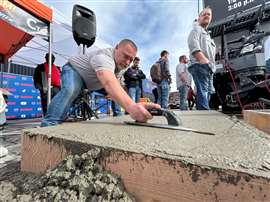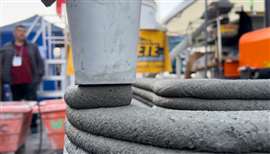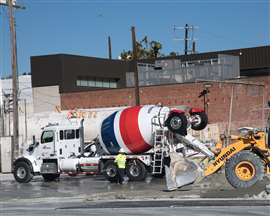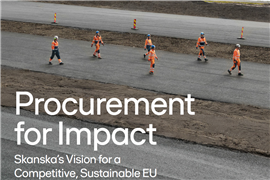Read this article in French German Italian Portuguese Spanish
Solid or soupy? A look at the global concrete industry
15 August 2025
Initial data on concrete volume sales from the UK shows demand for cement and concrete could be waning. Is it an outlier or a sign of a global construction pullback?
 Crews pour concrete for a major roadworks project. Image: Adobe Stock
Crews pour concrete for a major roadworks project. Image: Adobe Stock
Construction Briefing combed over the available data across the world, and here’s what we found.
Sharp decline in UK ready-mix concrete sales
 A concrete pouring demonstration at the 2024 World of Concrete show in Las Vegas, Nevada, US. (Image: Mitchell Keller)
A concrete pouring demonstration at the 2024 World of Concrete show in Las Vegas, Nevada, US. (Image: Mitchell Keller)
Ready-mix concrete volumes in the UK fell 11.5% year on year to 2.7 million m³ in the second quarter of 2025, according to new data from the Mineral Products Association (MPA). Rolling annual sales from Q3 2024 to Q2 2025 total 11.9 million m³ – the lowest in more than six decades.
And concrete and cement are not the only materials seeing lower demand. Volumes across all major mineral products are now at historically low levels, the MPA says.
“This quarter’s data offers a stark reminder that market conditions remain incredibly challenging for the mineral products sector. A fourth consecutive year of declining sales is now a serious risk, including to jobs,” says Aurelie Delannoy, MPA’s director of economic affairs.
The association cites evaporating business confidence, rising costs, and uncertainty over future taxation as key factors in the downturn. It also notes cancelled, delayed, or deferred investment decisions in infrastructure and ongoing uncertainty over roadbuilding as having an impact.
Cement is not covered by the new ready-mix figures, but the most recent annual data for 2023 shows weak sales, near record-low domestic production, and imports making up 32% of the UK market. The MPA attributes this to high electricity prices, high labour costs and a burdensome regulatory environment.
MPA executive chair Chris Leese adds, “Current trading conditions are the most difficult many of our members have ever experienced, including the 2007–08 financial crisis, while in concrete the data shows it’s the worst in a lifetime with no signs of recovery.”
The association is calling for the government to rule out further tax rises, accelerate infrastructure delivery, increase planning capacity, resolve various delays, reintroduce the super-deduction to support business investment, and ensure procurement supports domestic supply.
Rest of Europe showing resilience, assisted by sustainability push
 A 3D-printing robot builds sample concrete formwork. (Image: Mitchell Keller)
A 3D-printing robot builds sample concrete formwork. (Image: Mitchell Keller)
At least in Europe, the UK may be an outlier.
Public-facing cement and concrete data is scarce in much of Europe as of publication, but performance by some of the region’s biggest producers offers insight into market health.
In Germany, Heidelberg Materials reported Q1 2025 revenue up 5%, maintaining its full-year guidance and signalling stable demand for its cement and concrete products. The company says its Brevik, Norway plant pre-sold all 2025 output of its evoZero net-zero cement, accounting for half of its ~1 Mt capacity, signalling sustainability is a high priority for Heidelberg customers.
It’s an isolated example, but an encouraging sign that a German rebound is coming; according to Cembureau (the European Cement Association), 2023 saw a 16% decline in cement production and consumption. Data for 2024 is not yet available, but analysis suggests about a 5% decline year on year.
Swiss-based Holcim posted first-half 2025 net sales of €5.89 billion ($6.8 billion), with low-carbon product ECOPlanet cement making up 35% of cement revenues and ECOPact concrete representing 31% of ready-mix sales - both up from last year. Despite a 3.8% drop in nominal Q2 2025 sales, local-currency sales rose. The group expects 6–10% annual earnings before income and taxes growth through 2030, driven by its shift toward sustainable building products.
But above all in Europe, Spain is a clear standout. Cement consumption rose 6.5% year-on-year in H1 2025 to 7.76 Mt, making it the country’s best performance in five years.
Aniceto Zaragoza, general director at Oficemen (the Spanish Cement Manufacturers’ Association), attributes a 25.8% surge in tenders and an 8.6% rise in construction permits as the key growth drivers. In addition, Spain’s €163 billion ($189 billion) Recovery and Resilience Plan, including €67 billion ($78 billion) dedicated to green transition projects, is underpinning demand through investment in renewable infrastructure, energy projects, and industrial development.
Zaragoza notes, “Cement consumption continues to show positive figures, along the path we anticipated at the beginning of this year.”
While the picture should become clearer as more country-specific data becomes available, the early signs so far suggest previously hampered markets are recovering, while others are showing renewed strength.
US volumes stable, shifting to sustainable products
 Close up macro shot of crushed cement clinker fragments and particles before being ground into a fine powder for use in concrete and construction materials. Image: AdobeStock
Close up macro shot of crushed cement clinker fragments and particles before being ground into a fine powder for use in concrete and construction materials. Image: AdobeStock
Across the Atlantic, the US market for concrete and cement products remains strong, but there are some causes for concern.
On the downside, a US Geological Survey analysis notes domestic production of Portland and blended cements fell 4% in 2024 (86 million tonnes) but shipments to end users were about flat at 110 million tonnes. In its spring forecast, the ACA, or American Cement Association (formerly the Portland Cement Association), projected a 1.6% drop in cement consumption in 2025, citing “no obvious driver for cement consumption growth” amid high interest rates and construction market uncertainty.
But it’s another story for lower-emission cements, which now make up more than 60% of US consumption; an astonishing rise from an estimated 25% in 2023. The climb is credited in part by a nationwide shift toward Portland-limestone cement (PLC) and other carbon-reduced alternatives. Use of PLC is said to cut project carbon footprints by up to 10%, and all 50 state Departments of Transportation approved its use in 2024, helping drive demand.
While conventional cement products and concrete may be declining, carbon-reduced products are on the up. The ACA expects moderate growth to return in 2026–27; demand from data centre construction alone is forecast to require nearly 1 million metric tonnes of cement over the next three years, including 247,000 tonnes in 2025.
China slows, India surges, Saudi demand steady
 A cement truck at the Cemex Hollywood Concrete Plant in Los Angeles, California, US. Image: Adobe Stock
A cement truck at the Cemex Hollywood Concrete Plant in Los Angeles, California, US. Image: Adobe Stock
Looking at the Middle East and Asia, three of the largest regions for construction activity show a mixed bag, though there’s optimism cement and concrete demand will rise.
Cement production in China dropped 5.3% year-on-year in June 2025, reflecting persistent housing weakness amid a broader slowdown in building materials.
The main drag is housing. Property investment fell 11.2% year on year in the first half, while new construction starts by floor area dropped around 20%.
Policy support and non-residential spending should offer a partial offset, but infrastructure activity has not yet fully counteracted the residential slump. Without stronger intervention, 2025 is likely to finish as a down year for China’s cement volumes, but long-term analysis expects growth beyond.
Neighbouring India is moving in the opposite direction to slowing Western markets, with demand supported by major government infrastructure programmes, including the Bharatmala highway initiative and a wave of urban metro projects.
National output rose 6.7% year on year to 39.9 million tonnes, followed by a 9% jump in May to 39.6 million, according to official figures. Average cement bag prices in May climbed 8% year on year, reflecting strong pricing power alongside volume gains. For the full fiscal year 2024–25, cement consumption reached 453 million tonnes, a 6.3% increase from the prior year.
UltraTech Cement, the country’s largest producer, posted an 11% year-on-year increase in domestic sales volumes in the April-June 2025 calendar quarter and a 49% surge in net profit. Consolidated sales volumes rose to 36.8 million tonnes, with revenue up 13%. The company plans to add 21.6 million tonnes of capacity over the next two years to meet anticipated growth, underscoring confidence in sustained demand.
In Saudi Arabia, cement demand is holding firm on the back of large-scale infrastructure and giga-projects under the Vision 2030 programme. The Line, other Neom projects, and the Red Sea Project are all in active construction phases, keeping domestic producers near full utilisation. Leading provider Yamama Cement reported Q2 2025 sales volumes up 5% year on year, with cement sales across the Kingdom reported up 21%.
Analysts expect demand growth to remain through 2026 as major project timelines extend and public-sector investment remains high.
Global outlook: A little soup, but mostly solid
While the UK’s sharp drop in concrete sales stands out, the global picture is less uniformly negative.
Europe, the US, Saudi Arabia and India show either stable volumes or targeted growth, often driven by infrastructure and sustainability-led projects. Even in China’s slowing market, infrastructure is cushioning residential weakness, while India’s rapid expansion and Saudi Arabia’s steady giga-project pipeline point to regional momentum.
For now, the data suggests the UK is the exception rather than the rule and much of the global concrete industry is holding its ground or building for more.
STAY CONNECTED



Receive the information you need when you need it through our world-leading magazines, newsletters and daily briefings.
CONNECT WITH THE TEAM












